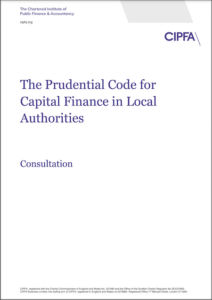
Following an updated process, the new Prudential Code is ready to come into force. David Green writes CIPFA listened to respondents.
Following its consultation on changes to the Prudential Code and the Treasury Management Code, CIPFA has published a summary of the responses received and feedback on its intentions going forward. I must say that I find this a refreshing change to its previous process where a new code was published without any reference to the prior consultation.
It’s fair to say that CIPFA received a lot of push back to some of its proposals: 96% of respondents who offered a view were against establishing a dedicated treasury management committee, while 77% voted down the introduction of a new practice statement on ESG (environmental, social and governance). Including a sustainability objective and specifying competencies for treasury managers were also out of favour with the majority of responses. As a result, the new codes seem likely to include more suggestions and less prescription in these areas. Hopefully, the difference between the statutory and the informal guidance will be made very clear.
16 September 2021
London Stock Exchange or ONLINE
13th Local Authority Treasurers’ Investment Forum
Room151’s flagship annual conference. Free attendance for local government treasurers and section 151 officers.
Lead sponsor CCLA
Public sector treasurers can register here
Definitions
The biggest change is the Prudential Code removing its ban on borrowing “more than or in advance of needs purely to profit from investment of the sums borrowed”.
 Instead, the prohibition will be on borrowing “to invest for the primary purpose of commercial return”. This covers off a major flaw in the current code where the need to borrow was not defined—many authorities decided that once contracts had been exchanged on a commercial property, they “needed” to borrow to complete the purchase. But the new wording will only work if a clear definition of a “commercial return” is given.
Instead, the prohibition will be on borrowing “to invest for the primary purpose of commercial return”. This covers off a major flaw in the current code where the need to borrow was not defined—many authorities decided that once contracts had been exchanged on a commercial property, they “needed” to borrow to complete the purchase. But the new wording will only work if a clear definition of a “commercial return” is given.
There was a favourable response to the code requiring capital expenditure and commercial investments to be proportionate. Few people want to see their local authority turned into a property fund that delivers public services as a side business.
But there was little clarity on when the level of investment would become disproportionate. I expect that a ban on borrowing for a commercial return will mean that new property investments are limited to those that can be funded from an authority’s own resources anyway, so a proportionality objective may be redundant.
Indicators
The prudential and treasury indicators look set for an overhaul, though not as drastic as originally proposed. The maturity structure of debt and the comparison of gross debt to the capital finance requirement (CFR) will be retained, while a proposed new indicator comparing debt to revenue stream will now not be implemented.
The big new indicator is the liability benchmark that indicates a low risk level of borrowing, taking multiple treasury risks into consideration.
This is to be shown graphically, unlike the tabular format of other indicators, and should extend for at least ten years into the future, which will make it more complex to produce and maybe more difficult to explain.
So, although the liability benchmark has been a recommendation in the Treasury Risk Management Toolkit for many years, it’s not surprising there was a mixed response to including this as a mandatory indicator.
CIPFA has, however, committed to providing substantial guidance on the indicator to enable it to be used effectively. Hopefully, this will encourage local authorities to assess their long-term cash flow needs before committing to long-term borrowing in the future.
Bold
In summary, the consultation process seems to have worked well. CIPFA made some bold proposals and after considering nearly 100 responses has softened some of the rough edges.
The new codes are due for publication in December, which is a bit too close to the start of the new financial year for compliance to be mandatory in 2022-23. But I expect the final proposed text will be published for the second round consultation before treasury managers start writing their capital and treasury management strategies in the autumn.
David Green is strategic director at Arlingclose Limited, treasury advisors to UK local authorities.













